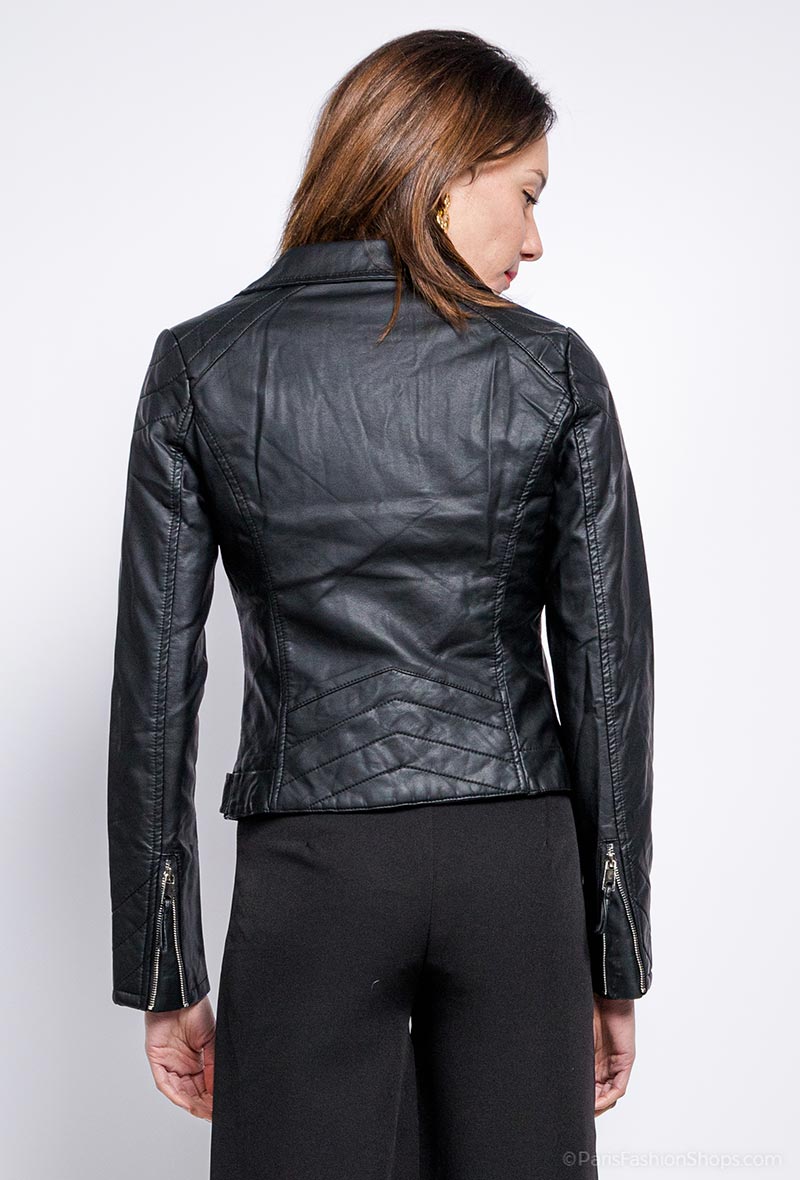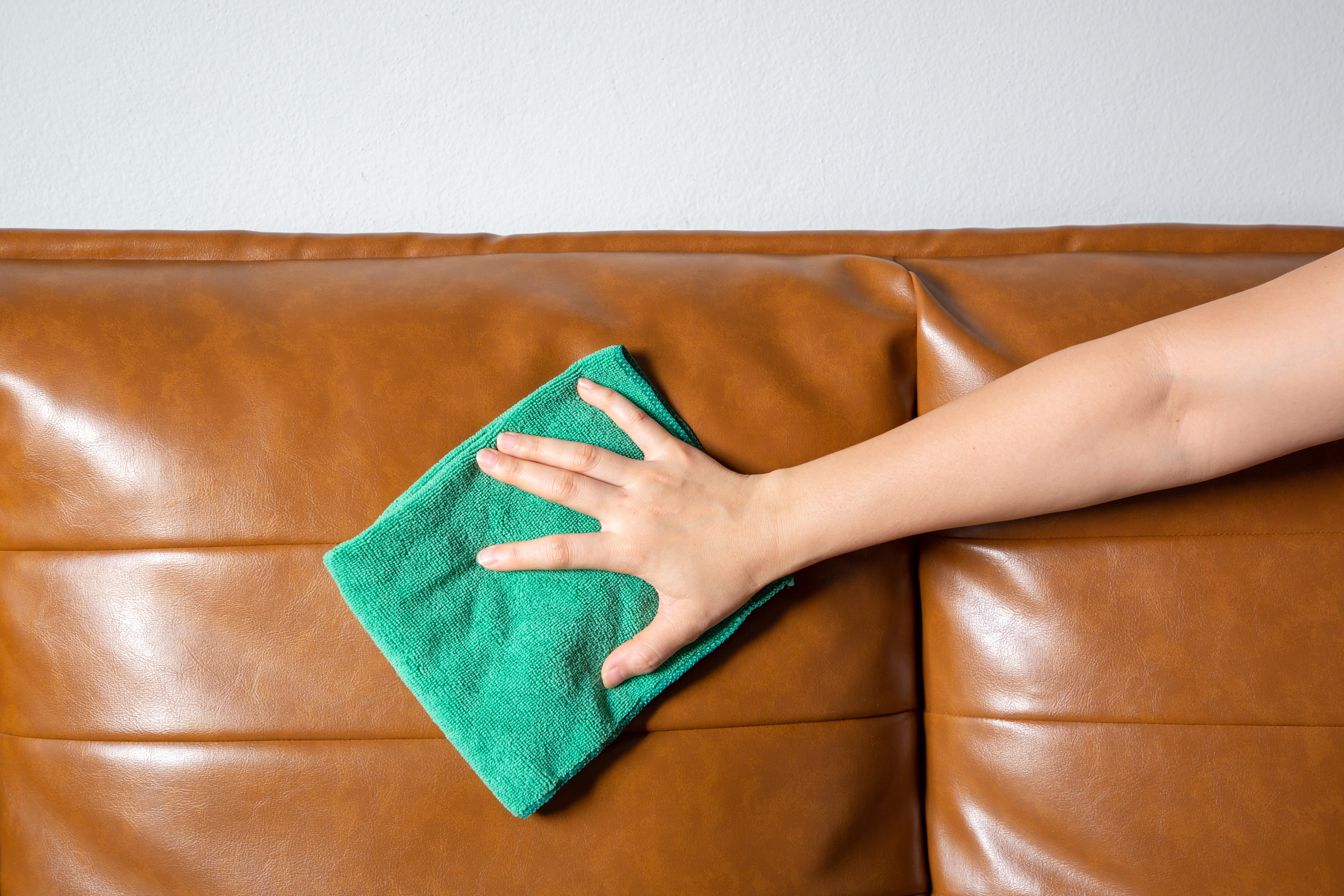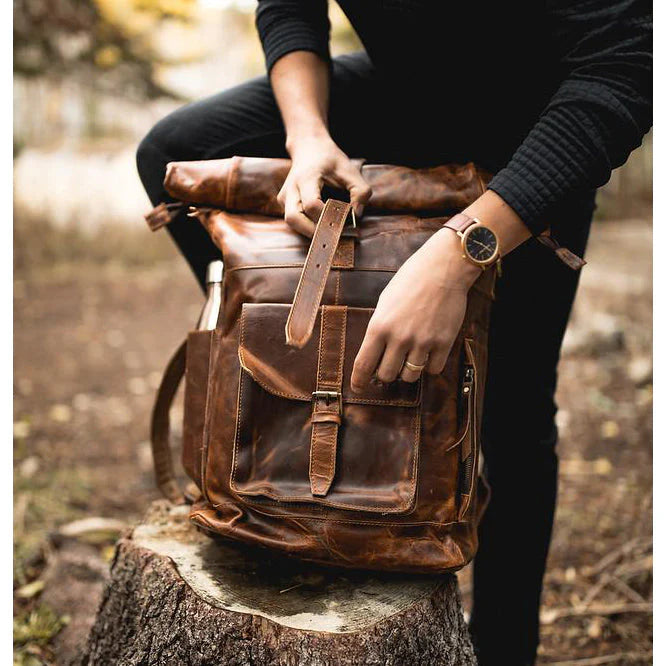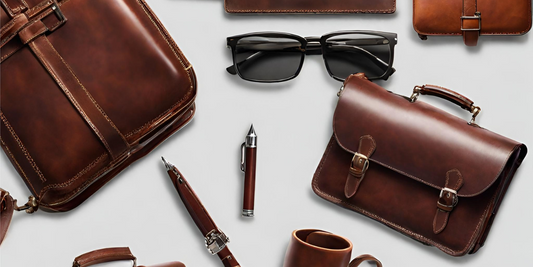It's hailed as the ethical alternative, the budget-friendly choice, but is pleather all it's cracked up to be?
It’s affordable, it’s versatile, and can anyone even tell it’s not the real thing?
Don't let its plastic charm fool you; there’s a bit more to this synthetic story than meets the eye.
From its environmental footprint to its lackluster durability, pleather has its drawbacks too.
Ready to find out all about pleather?
Let’s dive in.
What is Pleather?
Pleather, short for "plastic leather," is a synthetic material designed to mimic the look and feel of real leather.
It's a popular alternative for those who prefer not to use animal products or want a more affordable option.
However, because of its high plastic content and short life span, it may not be the most sustainable option.

Pleather vs. Real Leather
Pleather is simply a synthetic copy of real leather, but it doesn’t offer the same quality or longevity.
The appeal of real leathers like full grain and top grain are their texture, feel, and smell.
Pleather cannot properly replicate these natural qualities.
If you examine immediate costs, pleather will often be the cheaper option, but because its lifespan is so short comparatively, it’s often an expensive long-term choice.
For luxury goods, higher-quality materials are almost always the better option.
Their durability and ability to look better with age make them a unique and important staple for any wardrobe.
Are Pleather and Faux Leather the same?
Pleather and faux leather are often used interchangeably, but there can be small differences.
Faux leather is a broader term used to describe several synthetic materials, including waxes, dyes and polyvinyl chloride, while pleather specifically refers to a plastic-based material.
Faux leather can also be called PU leather, leatherette, synthetic leather and artificial leather and encompasses all these types.
Neither of these options offers a suitable alternative for real leather goods in terms of quality, durability, or longevity.

How Can I Spot Pleather?
Pleather is fairly easy to spot, especially when compared side-by-side to high-quality real leather.
Although it tries to mimic the texture and appeal of real leather, it often falls short.
To identify pleather, look for an unnaturally consistent texture, a lack of pores in the material, and a plastic or synthetic scent.
Unlike real leather, pleather will often have a uniform appearance and show no signs of individuality or carefully crafted design.
Advantages of Pleather
Pleather offers several advantages that make it an attractive choice for consumers:
1. Affordability
Compared to genuine leather, pleather is often more budget-friendly, making it accessible to a wider range of consumers.
2. Animal-Friendly
Pleather is a cruelty-free alternative to genuine leather, making it appealing to those who prefer not to use animal products.
3. Versatility
Pleather can be manufactured in a variety of colors, textures, and finishes, allowing for greater design flexibility in fashion and home decor.
4. Easy Maintenance
Pleather is generally easier to clean and maintain than genuine leather. It can often be wiped clean with a damp cloth, reducing the need for specialized leather care products.
5. Consistency
Unlike genuine leather, which can vary in quality and appearance, pleather offers consistent color and texture across batches, ensuring uniformity in finished products.

Disadvantages of Pleather
While pleather has its benefits, it also comes with some drawbacks that consumers should be aware of:
1. Durability
Pleather may not be as durable as genuine leather and can be prone to tearing or peeling over time, especially with heavy use.
2. Breathability
Unlike genuine leather, pleather is not breathable, which can result in discomfort when worn for extended periods, particularly in warm weather.
3. Environmental Impact
Although pleather is cruelty-free, its production still relies on petroleum-derived materials, which have environmental implications such as greenhouse gas emissions and resource depletion.
4. Quality Variation
The quality of pleather can vary significantly depending on the manufacturing process and materials used, leading to inconsistencies in texture, durability, and appearance.
5. Limited Lifespan
Pleather has a shorter lifespan compared to genuine leather, requiring more frequent replacement and contributing to waste in the long run.

History of Pleather
Pleather has a fascinating history that traces back to the early 20th century, when scientists in Germany began experimenting with synthetic materials as alternatives to natural resources.
The roots of pleather can be found in the early 20th century, with the invention of materials like cellulose acetate, PU (polyurethane), and PVC (polyvinyl chloride).
These synthetic polymers laid the groundwork for the creation of faux leather fabrics.
However, it wasn't until the mid-20th century that pleather gained popularity as a viable substitute for genuine leather.
During World War II, real leather became scarce because it was needed for various wartime supplies.
This shortage pushed researchers to work harder on finding alternatives.
They came up with PVC, a type of plastic that looked remarkably like leather but cost less.
After the war, as economies recovered, people in primarily English-speaking countries like the US and UK started using pleather more because it offered a similar look to real leather but at a lower price.
Over time, as technology improved, pleather became even more convincing as a leather substitute.
Today, it's commonly found in clothing (such as jackets, leggings, or even cosplay outfits), accessories, and upholstery.

How is Pleather made?
Creating pleather involves several key steps that transform raw materials into the finished product you see in stores:
1. Getting the Basics
It all starts with picking the right stuff.
Many materials are gathered, depending on the final use of the pleather. Examples are acrylic, polyester blends, marine vinyl fabrics and more.
Pleather makers most commonly use special plastics, often derived from oil or natural gas.
2. Mixing Things Up
These plastics go through a process called polymerization, where they're heated and mixed until they form long chains.
This makes the material strong and flexible.
3. Turning Up the Heat
Next, the polymer mix is melted down and shaped into thin sheets.
This can happen by squeezing it through a mold (extrusion) or pouring it onto a surface to cool (casting).
4. Adding Texture
To make it feel like leather, the sheets get textured. Machines press patterns onto the surface, giving it that classic leather look.
5. Splash of Color
After texture, it's time to add color. With pleather, you stray away from the simple browns of real leather and look towards other colors like red, blue, green etc.
Dyes and pigments are applied to the sheets, making them look like real leather.
They can be sprayed on or dipped, depending on the desired effect.
6. Finishing Touches
Some extra treatments might be added for durability or water resistance.
This step ensures that the pleather can withstand everyday wear and tear.
7. Quality Check
Throughout the process, quality checks are done to make sure everything looks and feels right.
This ensures that the even variants like stretch pleather meet standards for strength, color, and texture.
8. Cut and Sew
Finally, pleather sheets are cut by the yard into pieces and stitched together to make various products like jackets, bags, or furniture.
How to Care for Pleather
Keeping your pleather items in good condition doesn't have to be complicated. Here are some simple tips to help you care for your pleather products and extend their lifespan:
1. Regular Cleaning
To keep your pleather items looking their best, regularly wipe them down with a damp cloth to remove dust and dirt.
For tougher stains, use a mild soap or detergent solution and gently scrub the affected area.
Avoid harsh chemicals or abrasive cleaners, as they can damage the surface of the pleather.
2. Avoid Heat and Sunlight
Prolonged exposure to heat and sunlight can cause pleather to dry out and crack.
Store your pleather items away from direct sunlight and sources of heat, such as radiators or heaters.
If your pleather items do get wet, allow them to air dry naturally away from heat sources.
3. Use a Conditioner
Just like genuine leather, pleather can benefit from occasional conditioning to keep it supple and moisturized.
Look for a specially formulated pleather conditioner and follow the manufacturer's instructions for application.
Conditioning your pleather items every few months can help prevent cracking and maintain their appearance.
4. Handle with Care
Avoid placing heavy objects on top of pleather items or subjecting them to excessive stress or strain.
Be mindful of sharp objects that could scratch or puncture the surface of the pleather.
When storing pleather bags or accessories, stuff them with tissue paper to help maintain their shape and prevent creasing.
5. Store Properly
When not in use, store your pleather items in a cool, dry place away from moisture and humidity.
Use breathable storage containers or fabric dust bags to protect them from dust and dirt.
Avoid folding or compressing pleather items for long periods, as this can cause creases and distortions in the material.

Environmental Impact of Pleather
While pleather is often marketed as a better choice for the environment, it might not be as eco-friendly as it seems.
Here's why:
1. Using Up Resources
Pleather is usually made from materials like oil, which aren't unlimited.
Getting these materials can harm the environment, by destroying habitats and polluting water.
2. Making Pollution
Making pleather fabric takes a lot of energy and uses chemicals that are bad for the environment.
These chemicals can get into the air, water, and soil, hurting plants, animals, and people.
3. Sticking Around Forever
Unlike things made from natural materials, pleather fabric doesn't break down easily.
When we throw away pleather stuff, it stays in the environment for a long time, adding to the problem of plastic waste.
4. Hard to Recycle
Even though some people try to recycle pleather, it's not easy.
Not many places can recycle it, so most of it ends up in landfills or being burned, which isn't good for the environment.

Should I buy a Pleather Bag?
In the debate between pleather and genuine leather bags, we believe the scales tilt decidedly in favor of the latter.
While pleather may appear to offer a budget-friendly and animal-friendly alternative to genuine leather, a closer examination reveals significant drawbacks that outweigh any perceived benefits.
Genuine leather bags stand out as the superior choice for several compelling reasons.
1. Quality
Firstly, their unmatched durability ensures that they can withstand the test of time, remaining a timeless investment for years to come.
This is super important for backpacks, handbags and duffles that you might want to last a really long time.
Unlike pleather fabric, which is prone to peeling, cracking, and fading, genuine leather bags develop a rich patina with age, enhancing their beauty and character.
Moreover, genuine leather bags boast unparalleled quality craftsmanship, often handcrafted by skilled artisans with meticulous attention to detail.
From the carefully stitched seams to the premium hardware, every aspect of a genuine leather bag exudes luxury and sophistication.
In contrast, pleather bags fall short in terms of both quality and longevity.
Their synthetic composition renders them more susceptible to wear and tear, diminishing their aesthetic appeal and structural integrity over time.
2. Environmental Factors
Additionally, the environmental impact of pleather production cannot be overlooked, as it relies on petroleum-based materials and chemicals that contribute to pollution and resource depletion.
3. An Investment
While pleather may initially seem like a more affordable option, its limited lifespan and lower resale value ultimately make it a poor investment compared to genuine leather.
Even lower grade real leathers like suede not only offer superior durability and craftsmanship but also hold their value over time, making them a more sustainable and economically prudent choice.
In conclusion, when faced with the decision of whether to buy a pleather or genuine leather bag, the answer is clear: opt for genuine leather.
By choosing quality over quantity, you'll not only enjoy a timeless accessory but also make a more environmentally conscious and financially sound investment in the long run.
Looking for real leather bags? On this website, you can find The Real Leather Company’s premium collection of leather messengers, backpacks, laptop bags, wallets and more.
Check out our sale prices, which often have discounts of up to 20% on the regular prices. Add our bags to your mental wishlist and checkout with confidence, knowing our return policy lets you send anything back at any time.

FAQs
1. Is pleather the same as genuine leather?
No, pleather, short for "plastic leather," is a synthetic material made from plastic, while genuine leather comes from animal hides.
Pleather is designed to mimic the look and feel of real leather but is made entirely from synthetic materials.
2. Is pleather environmentally friendly?
While pleather is often marketed as a more sustainable alternative to genuine leather, its production still relies on petroleum-based materials and chemicals that can harm the environment.
Additionally, pleather is not biodegradable and contributes to plastic pollution when disposed of.
3. How do I clean pleather?
Pleather can be cleaned with a damp cloth and mild soap or detergent solution to remove dirt and stains.
Avoid harsh chemicals and abrasive cleaners, as they can damage the surface of the material.
Conditioning pleather periodically can help maintain its suppleness and appearance.
4. Is pleather durable?
Pleather is generally less durable than genuine leather and may be prone to peeling, cracking, and fading with prolonged use.
Genuine leather, on the other hand, is known for its strength and longevity, making it a more durable choice for bags and accessories.
5. Can pleather be recycled?
While efforts are being made to improve recycling technologies for synthetic materials like pleather, current recycling rates remain low due to technical challenges and lack of access to infrastructure.
As a result, the majority of pleather products end up in landfills or incinerators at the end of their use.
6. Is pleather cruelty-free?
Yes, pleather is considered a cruelty-free alternative to genuine leather, as it does not involve the use of animal products. Pleather is considered a vegan leather.
However, it's essential to consider the environmental impact of pleather production and its reliance on non-renewable resources.















